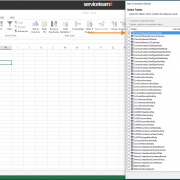Microsoft Azure is a cloud computing service for managing applications and services. Azure was announced in October 2008 as Windows Azure before changing its name to Microsoft Azure in 2014.
Microsoft Azure is a widely used computing service, with over 600 Azure services for users, you would think that an Intern for an IT company would be an expert, right? Well, sadly no. I’m the first to admit that as well as lacking knowledge in AWS, I knew as much about that as I did Azure.
However, fast forward a few weeks, and while I’m still no expert, I think I know my fair share and it’s all down to this glossary of key terms. While I used it to build my knowledge pretty much from scratch, it can also be used to fill in any gaps or even to refresh your memory. Either way, I can honestly say that without this glossary, I wouldn’t have been able to do half of the things I have – blagging can only take you so far.
What is Microsoft Azure
Microsoft Azure is a cloud service from the global software giant, Microsoft. Azure offers a vast range of useful compute and application resources. These are all offered on-demand and in a cost-effective manner which helps businesses scale and grow.
What I have learnt from creating this glossary is that even the complicated sounding terminology usually has a simple explanation. Which can be useful when developing your knowledge on technical topics. I must stress that these do not need to be committed to memory – and you certainly don’t need to know the ins and outs of every detail.
Microsoft Azure Glossary
App Service App – this app provides resources for hosting a website or web application or mobile app back end.
Affinity Group- these ensure that resources created within the same affinity group are hosted by servers that are close together. This enables these resources to communication quicker and easier.
Availability set – is a collection of virtual machines that are managed together to provide application redundancy and reliability. This use of this ensures that during either a planned or unplanned maintenance event at least on virtual machine is available.
Azure Classic Deployment Model – this is a model used to deploy resources in Azure.
Azure command-line interface (CLI) – this interface can be used to manage Azure services from Windows, macOS and Linux.
Azure PowerShell – this is a command-line interface to manage Azure services via a command line from Windows PCs.
Blob Storage – this is storage that handles all unstructured data, scaling up or down as your needs change. This storage means that users will no longer have to manage it which saves time and effort.
Cloud Services – allows you to develop, package and deploy applications and services to the cloud.
Endpoint – Endpoints allow you to make VMs placed in different networks, irrespective of whether it is within Azure/on premise/other cloud.
Instance Level Public IP Address – these are associated directly to the Virtual Machines Instances rather than to the Cloud Services when you back all the Virtual Machines within.
Public Virtual IP Address – when you create a Cloud Service in Azure, you will be assigned with Virtual Public IP Address. This address will not be released until all the VMs placed insider the Cloud services is successfully deleted or stopped.
Portal – this is a secure portal used to deploy and manage Azure services. There are two portal Azure portal and Classic Portal.
Region – this is an area that does not cross national borders and contain one or more data centers.
Resource – this is an item that is a part of your Azure solution that users can use to deploy different types of resources.
Resource group – this service holds related resources for an application which is located within Resource Manager.
Shared access signature (SAS) – this is a signature that enables you to grant limited access to a resource, without exposing your account key.
Regional Virtual Network (VNet) – is a service in which enables users to securely connect Azure resources to each other using virtual networks. A VNet is a representation of your own network in the cloud.
Resource Group – this is a container that holds related resources for an Azure solution. The resource group can include all resources for the solution or only ones that that you want to manage as a group.
Reserved Virtual IP Address – users can reserve IP addresses for the subscription.
Storage Account – this is an account in which gives users access to the Azure Blob, Queue, Table, and File services in Azure storage.
Subscription – this is an agreement between a customer and Microsoft in which enables the user to obtain Azure services. The pricing is dependent on the offer chosen for the subscription.
Tag – this is an indexing terms that enables users to categorise resources for ease of management or billing. This enables users to organise complex collections of resources in an easy manner.
Virtual Network – this is a network that provides connectivity between your Azure resources that is located from all other Azure tenants.
Virtual Machine – multiple virtual machine can run at the same time and they allow the software implementation of a physical computer that runs an operating system.
Virtual Machine Extension – this is a resource in which implements behaviours or feature that either help other programs work or give the ability for the user to interact with a running computer.
X-PLAT CLI – this is a command line interface for Windows, Linux and IOS Platforms.
I hope that you will find this Microsoft Azure glossary just as useful as I did, whether that’s to learn something brand new or to expand and refresh your knowledge. Feel free to leave a comment in the section below about any questions or suggestions you may have.










Leave a Reply
Want to join the discussion?Feel free to contribute!